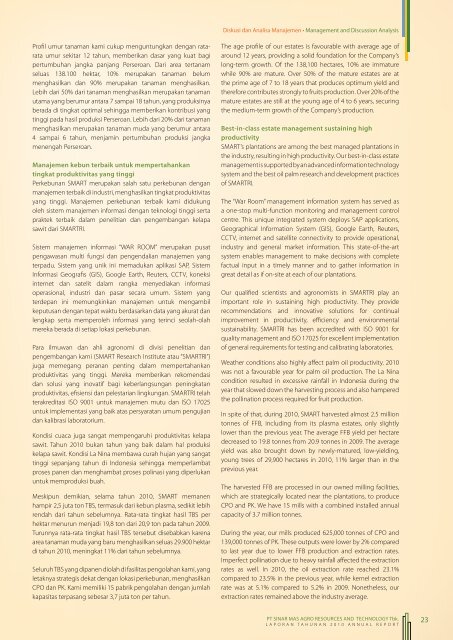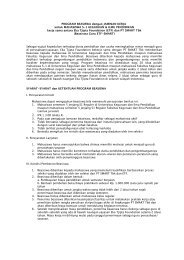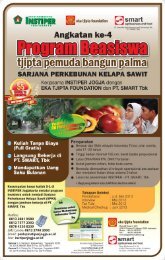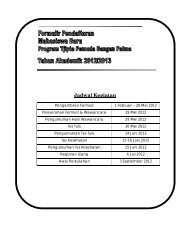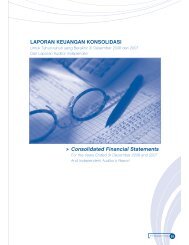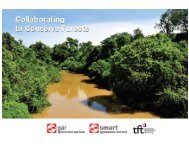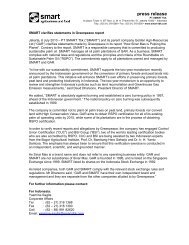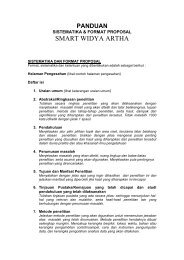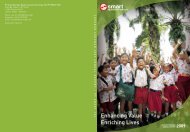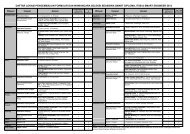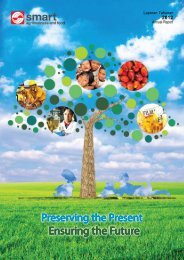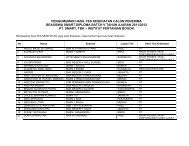Annual Report - PT SMART Tbk
Annual Report - PT SMART Tbk
Annual Report - PT SMART Tbk
- No tags were found...
You also want an ePaper? Increase the reach of your titles
YUMPU automatically turns print PDFs into web optimized ePapers that Google loves.
Diskusi dan Analisa Manajemen • Management and Discussion AnalysisProfil umur tanaman kami cukup menguntungkan dengan ratarataumur sekitar 12 tahun, memberikan dasar yang kuat bagipertumbuhan jangka panjang Perseroan. Dari area tertanamseluas 138.100 hektar, 10% merupakan tanaman belummenghasilkan dan 90% merupakan tanaman menghasilkan.Lebih dari 50% dari tanaman menghasilkan merupakan tanamanutama yang berumur antara 7 sampai 18 tahun, yang produksinyaberada di tingkat optimal sehingga memberikan kontribusi yangtinggi pada hasil produksi Perseroan. Lebih dari 20% dari tanamanmenghasilkan merupakan tanaman muda yang berumur antara4 sampai 6 tahun, menjamin pertumbuhan produksi jangkamenengah Perseroan.Manajemen kebun terbaik untuk mempertahankantingkat produktivitas yang tinggiPerkebunan <strong>SMART</strong> merupakan salah satu perkebunan denganmanajemen terbaik di industri, menghasilkan tingkat produktivitasyang tinggi. Manajemen perkebunan terbaik kami didukungoleh sistem manajemen informasi dengan teknologi tinggi sertapraktek terbaik dalam penelitian dan pengembangan kelapasawit dari <strong>SMART</strong>RI.Sistem manajemen informasi “WAR ROOM” merupakan pusatpengawasan multi fungsi dan pengendalian manajemen yangterpadu. Sistem yang unik ini memadukan aplikasi SAP, SistemInformasi Geografis (GIS), Google Earth, Reuters, CCTV, koneksiinternet dan satelit dalam rangka menyediakan informasioperasional, industri dan pasar secara umum. Sistem yangterdepan ini memungkinkan manajemen untuk mengambilkeputusan dengan tepat waktu berdasarkan data yang akurat danlengkap serta memperoleh informasi yang terinci seolah-olahmereka berada di setiap lokasi perkebunan.Para ilmuwan dan ahli agronomi di divisi penelitian danpengembangan kami (<strong>SMART</strong> Research Institute atau “<strong>SMART</strong>RI”)juga memegang peranan penting dalam mempertahankanproduktivitas yang tinggi. Mereka memberikan rekomendasidan solusi yang inovatif bagi keberlangsungan peningkatanproduktivitas, efisiensi dan pelestarian lingkungan. <strong>SMART</strong>RI telahterakreditasi ISO 9001 untuk manajemen mutu dan ISO 17025untuk implementasi yang baik atas persyaratan umum pengujiandan kalibrasi laboratorium.Kondisi cuaca juga sangat mempengaruhi produktivitas kelapasawit. Tahun 2010 bukan tahun yang baik dalam hal produksikelapa sawit. Kondisi La Nina membawa curah hujan yang sangattinggi sepanjang tahun di Indonesia sehingga memperlambatproses panen dan menghambat proses polinasi yang diperlukanuntuk memproduksi buah.Meskipun demikian, selama tahun 2010, <strong>SMART</strong> memanenhampir 2,5 juta ton TBS, termasuk dari kebun plasma, sedikit lebihrendah dari tahun sebelumnya. Rata-rata tingkat hasil TBS perhektar menurun menjadi 19,8 ton dari 20,9 ton pada tahun 2009.Turunnya rata-rata tingkat hasil TBS tersebut disebabkan karenaarea tanaman muda yang baru menghasilkan seluas 29.900 hektardi tahun 2010, meningkat 11% dari tahun sebelumnya.Seluruh TBS yang dipanen diolah di fasilitas pengolahan kami, yangletaknya strategis dekat dengan lokasi perkebunan, menghasilkanCPO dan PK. Kami memiliki 15 pabrik pengolahan dengan jumlahkapasitas terpasang sebesar 3,7 juta ton per tahun.The age profile of our estates is favourable with average age ofaround 12 years, providing a solid foundation for the Company’slong-term growth. Of the 138,100 hectares, 10% are immaturewhile 90% are mature. Over 50% of the mature estates are atthe prime age of 7 to 18 years that produces optimum yield andtherefore contributes strongly to fruits production. Over 20% of themature estates are still at the young age of 4 to 6 years, securingthe medium-term growth of the Company’s production.Best-in-class estate management sustaining highproductivity<strong>SMART</strong>’s plantations are among the best managed plantations inthe industry, resulting in high productivity. Our best-in-class estatemanagement is supported by an advanced information technologysystem and the best oil palm research and development practicesof <strong>SMART</strong>RI.The “War Room” management information system has served asa one-stop multi-function monitoring and management controlcentre. This unique integrated system deploys SAP applications,Geographical Information System (GIS), Google Earth, Reuters,CCTV, internet and satellite connectivity to provide operational,industry and general market information. This state-of-the-artsystem enables management to make decisions with completefactual input in a timely manner and to gather information ingreat detail as if on-site at each of our plantations.Our qualified scientists and agronomists in <strong>SMART</strong>RI play animportant role in sustaining high productivity. They providerecommendations and innovative solutions for continualimprovement in productivity, efficiency and environmentalsustainability. <strong>SMART</strong>RI has been accredited with ISO 9001 forquality management and ISO 17025 for excellent implementationof general requirements for testing and calibrating laboratories.Weather conditions also highly affect palm oil productivity. 2010was not a favourable year for palm oil production. The La Ninacondition resulted in excessive rainfall in Indonesia during theyear that slowed down the harvesting process and also hamperedthe pollination process required for fruit production.In spite of that, during 2010, <strong>SMART</strong> harvested almost 2.5 milliontonnes of FFB, including from its plasma estates, only slightlylower than the previous year. The average FFB yield per hectaredecreased to 19.8 tonnes from 20.9 tonnes in 2009. The averageyield was also brought down by newly-matured, low-yielding,young trees of 29,900 hectares in 2010, 11% larger than in theprevious year.The harvested FFB are processed in our owned milling facilities,which are strategically located near the plantations, to produceCPO and PK. We have 15 mills with a combined installed annualcapacity of 3.7 million tonnes.During the year, our mills produced 625,000 tonnes of CPO and139,000 tonnes of PK. These outputs were lower by 2% comparedto last year due to lower FFB production and extraction rates.Imperfect pollination due to heavy rainfall affected the extractionrates as well. In 2010, the oil extraction rate reached 23.1%compared to 23.5% in the previous year, while kernel extractionrate was at 5.1% compared to 5.2% in 2009. Nonetheless, ourextraction rates remained above the industry average.<strong>PT</strong> Sinar Mas Agro Resources and Technology <strong>Tbk</strong>.Laporan Tahunan 2010 AnNual <strong>Report</strong>23


